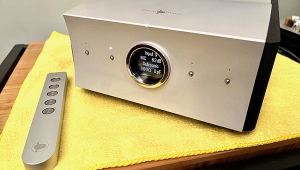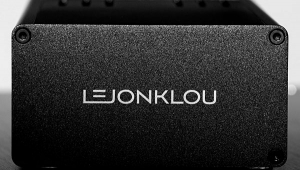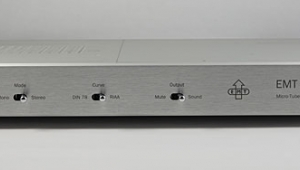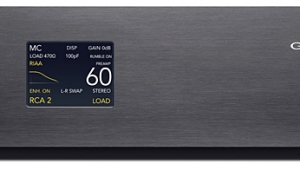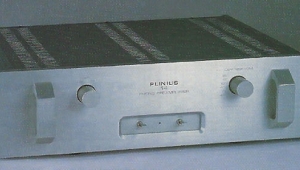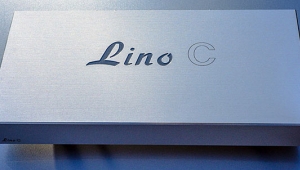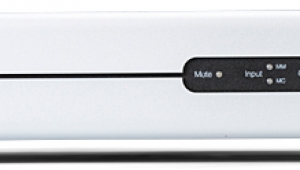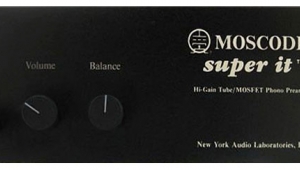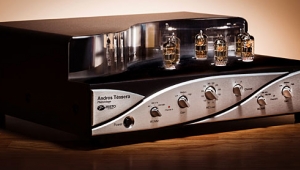| Columns Retired Columns & Blogs |
Robert J. Reina, February 2012
Robert J. Reina wrote about the Parasound Halo JC 3 in February 2012 (Vol.35 No.2):
Footnote 1: In that same conversation I learned that Wilson and I used the same analog front-end in our reference systems: a Koetsu Urushi cartridge loaded at 100 ohms into a Vendetta SCP-2.—Robert J. Reina
I was intrigued by a sentence in Brian Damkroger's rave review of the Parasound Halo JC 3 phono preamplifier3 in the October 2011 issue: "The simplest way to describe the JC 3 is as a Vendetta SCP-2 [phono preamplifier] executed with integrated rather than discrete circuits." As I've used a Vendetta SCP-2 as my reference phono stage in my most expensive reference system for 22 years now, I thought it would be interesting to get a Halo JC 3 in-house and compare them—especially as both were designed by John Curl. (J. Gordon Holt reviewed the Vendetta for Stereophile in June 1988.)
My love affair with the Vendetta SCP-2 has waned not one jot in the last two decades. I was smitten with how delicate low-level dynamic articulations emerged from its black backgrounds, and how it rendered all vocal and instrumental textures with crystalline clarity and precise delineation of holographic images on a deep, wide soundstage. The SCP-2's greatest strength was its deep, precise, uncolored, thundering bass, and the most effortless sense of high-level dynamic slam I'd heard from any component. I began in 1989 with the A version of the Vendetta, which possessed all the attributes mentioned above, and sounded dead neutral except for a very slight "bite" in the lower high frequencies. When I sent that unit back to John Curl at Vendetta for its B upgrade, that bite was eliminated. A few years later, when I had my SCP-2B upgraded to D status, all of its strengths were improved by another notch.
The Vendetta SCP-2D is the quietest audio component I've ever had. Every time I changed a component in my system, I needed to touch the Vendetta's cabinet to feel the slight warmth that verifies that it's on (it has no pilot light)—turning the preamplifier's volume up to max gave me no hint. It's also the most reliable component I've ever had in my system. The SCP-2 has no on/off switch; except for two moves of house and the two trips back to Curl for updates, my SCP-2 has been turned on for 22 years, and has run flawlessly the whole time.
About 10 years ago, John Curl asked if I'd like a significant update to the Vendetta, based on the phono stage he'd incorporated into his CTC Blowtorch preamplifier ($15,000), which he'd designed with Carl Thompson and the late Bob Crump. But when he indicated that the changes in the sound would be more significant than the B and D upgrades, I declined. I was afraid to risk the loss of my SCP-2D's gorgeous sound, or lack thereof.
Although it's no longer available, it's significant that the solid-state SCP-2 has remained in my reference system longer than any other electronic component, given my preference for expensive tubed gear. Over the last 20 years I've listened to many different phono stages in the homes of Stereophile reviewers and friends, in the reference systems of audio designers, and at shows and dealers. Many of these products have had prices in four and five figures, but I've never had the slightest interest in considering any of them as potential replacements for the Vendetta SCP-2D.
In a conversation I had with him in the 1990s, speaker designer Dave Wilson, of Wilson Audio Specialties, described John Curl as "the master of low-level signal amplification."3 The market in used audio gear apparently agrees: The SCP-2 is the only preamp I'm aware of, other than vintage tubed Marantz and McIntosh models, that currently trades for more than twice its original price. As I cranked up the Parasound Halo JC 3 ($2350), I thought it would be a tall order for this rugged and relatively affordable phono stage to approach the performance of my Vendetta.
The Halo JC 3's neutral, detailed midrange made it a good match for well-recorded jazz piano discs. When I played Bill Evans at the Montreux Jazz Festival (45rpm single-sided LPs, Verve/Classic 6-8762), Evans's piano was reproduced with all its woody timbres intact, and with a sense of natural and linear microdynamics. The high frequencies were pristine, extended, and airy. I could hear all of the upper harmonics of John Renbourn's steel-string flattop guitar in his The Nine Maidens (LP, Flying Fish FF378). Similarly, Miles Davis's trumpet in "Surrey with the Fringe on Top," from Steamin' (LP, Prestige 7200), had the requisite sharp metallic bite as well as a long, silky reverberant decay. My favorite version of Duke Ellington's "Caravan" is the rockabilly arrangement from Santo & Johnny's eponymous album (LP, Canadian American CALP1001). Despite the rapidity of Santo Farina's phrasing, every note of his blazing pedal-steel solo chimed like a golden bell on its own bed of air.
The Parasound's high-frequency realism dovetailed nicely with its perfect reproduction of transients. The transient coherence of Art Blakey's drumming in Bobby Timmons's "Moanin'," from Art Blakey and the Jazz Messengers (LP, Blue Note BN4003), made it very easy to visualize the panoramic display of Blakey's kit, as he put every one of his drums and cymbals through its paces with a wide range of timbres and dynamic envelopes. And it was easy to follow every subtle dynamic nuance of the New Jersey Percussion Ensemble's battery of instruments in Charles Wuorinen's frequently cacophonous Ringing Changes for Percussion Ensemble (LP, Nonesuch 71263).
The Parasound's bass reproduction was beyond reproach. In "Lord's Tundra," from his Ucross (LP, Jazz Planet JP5002-1), Dean Peer's eight-string electric bass was thundering, clean, and precise throughout its range, with no trace of compression or overhang, or loss of bottom-end clarity. My acid test for high-level dynamic slam are the tutti passages in "Bluesville," from Count Basie's 88 Basie Street (45rpm LPs, Pablo/Analogue Productions 2310-901). In these fff passages there was no hint of strain, compression, or limiting, and the brass and rhythm sections slammed me in the chest as if I were hearing them in live performance.
I listened to most of the above recordings through the Vendetta SCP-2 as well. I was amazed that, with respect to transient articulation, timbral purity, low- and high-level dynamic articulation, and bass extension and control, I could hear no difference whatever between the two phono stages through my most revealing reference system. In two areas, however, the Vendetta produced a slight improvement over the Parasound. First, there was a bit more high-frequency purity; I was able to hear more subtle upper-frequency harmonic information. For example, in the Wuorinen percussion work, the various metals of the different percussion instruments sounded more distinct from each other. Second, the Vendetta revealed a bit more hall sound, air, decay, and ambience with well-recorded jazz and classical music. Otherwise, it was staggering how similar the two models sounded. These small differences were what you'd expect to hear between the standard and "signature" versions of a hypothetical preamplifier, the latter boasting slightly more expensive components in the same circuit.
The Parasound Halo JC 3 re-created at least 90% of the performance of my Vendetta SCP-2D phono stage. Those thinking of shelling out for a used Vendetta are likely to be just as satisfied with a new Parasound. And they can spend the savings on a new cartridge.—Robert J. Reina
Footnote 1: In that same conversation I learned that Wilson and I used the same analog front-end in our reference systems: a Koetsu Urushi cartridge loaded at 100 ohms into a Vendetta SCP-2.—Robert J. Reina
- Log in or register to post comments
